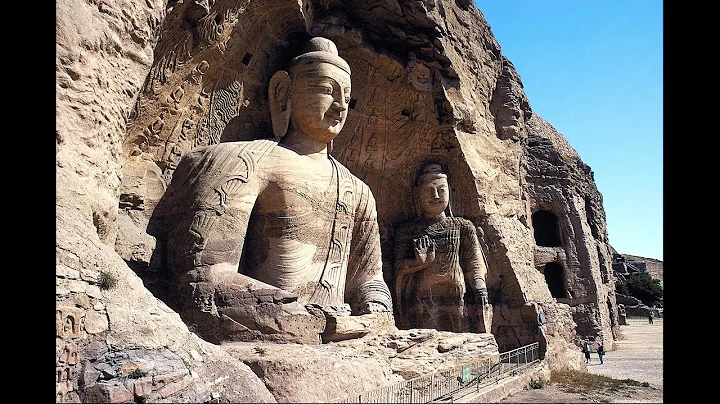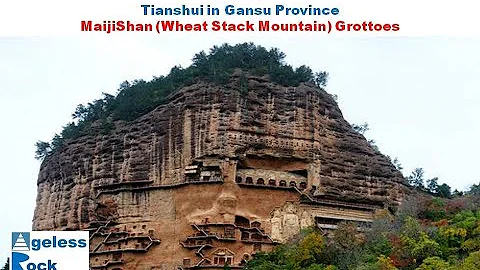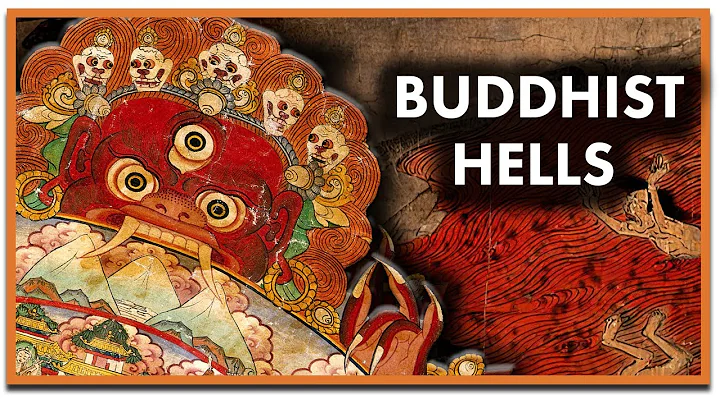The caves are "as dense as honeycombs" and the plank roads are "flying in the sky." Maijishan Grottoes , one of the four major grottoes in China, are excavated on the cliff. According to ancient records, the Maijishan Grottoes were built by "six countries. They accumulated salary from the ground, and then went to the top of the rock to carve out the Buddha statue in the niche. After the work was completed, they turned around and folded the salary to go down, and then climbed up dangerously on the empty ladder." "Although it is done by human power, I doubt it is a ghost.
Among the many grottoes in China, Maiji Mountain has the best natural scenery. Maiji Mountain is located at the northern foot of the western section of the Qinling Mountains. It is a typical Danxia square mountain landform. The rock walls are upright and red like morning glow. When you look at them, they look like farmers piling wheat, so it is named Maiji Mountain. The trees on the mountain are green and the clouds are misty. Nestled among the sea-like green pines and bursts of clouds, there are three standing Buddha statues and as many as 221 caves, as well as more than 10,600 clay sculptures and more than 1,300 square meters of murals in the caves.

Compared with Dunhuang, which is known as the "Great Mural Hall", Maijishan's art is famous for its clay sculptures. Here, the artists have abandoned the meticulous attention to detail in the past and raised their appeal to a level that dominates everything: Buddha, Bodhisattvas, disciples, and donors are all artistic processing covering exaggeration, imagination, summary, and refinement of all living beings. Their expressions are moving and full of life, and they look like they have seen each other before. A foreign scholar who specializes in the study of the Maijishan Grottoes once compared the Buddha statues in the Maijishan Grottoes to "the smiling Buddhas in the sea of clouds."
From the beginning of the Later Qin Dynasty to the Northern Wei Daxing, through the Western Wei , Northern Zhou , Sui, Tang, Song and even the Yuan, Ming and Qing dynasties, the artistic works in the Maijishan Grottoes, whether they are statues or murals , all have their own unique personalities and strong cultural continuity. From the simplicity and solemnity of the Later Qin Dynasty, to the delicate bones and clear elephants of the Northern Wei Dynasty, to the round pearls and jade in the Northern Zhou Dynasty, to the plumpness and roundness of Sui and Tang , and the realistic changes of and Song , China's sculpture style and even aesthetics have evolved over more than a thousand years. The evolution of orientations has a clear context to follow, providing the best research objects for research on the history of Chinese national sculpture, painting, crafts, architecture, religion, and philosophical thought.

As a treasure house of Buddhist art in China, it is also a precious religious cultural heritage in the process of human civilization. Many of the statue combinations, techniques and characteristics of the Maijishan Grottoes are not found in other grottoes. Therefore, they represent a unique artistic achievement and a unique cultural heritage. A masterpiece of creative genius. However, due to the relatively rainy and humid environment of Maiji Mountain and the frequent earthquakes in history, some caves and their statues were damaged. Some statues detached from the cliff and fell naturally, while the murals appeared hollow, mildewed, and the mud peeled off. Disease, it was later properly protected and became a cultural relic protection unit. As every tourist, we have the responsibility to protect and care for cultural relics.
In 1961, the State Council listed the Maijishan Grottoes as the first batch of national key cultural relics protection units. In order to protect this magnificent art treasure cave as much as possible of its original appearance, relevant units even carried out an 8-year maintenance and reinforcement project on the mountain.

"Whose wheat stacks are hundreds of meters high, and flying stacks are floating in the sky. Thousands of caves and caves are filled with ghosts and axes, and the Buddha is carved with skillful craftsmanship." A scholar who devoted his life to the archaeological research of the Maijishan Grottoes once said: " More than 20 years have passed, and as an ordinary research librarian at the Maijishan Grottoes Art Research Institute, I am still a primary school student who piously flips through books in front of the ancient Maijishan Grottoes, which is like a book that has been gathering dust for many years. Ancient books are waiting for us to read. "
Let us experience the Maijishan Grottoes and feel the huge shock of traveling through time and space brought by the ancient grottoes and ten thousand statues.


















![[English] Who Am I - Lecture 1 - Ven. Guan Cheng - DayDayNews](https://i.ytimg.com/vi/KU0fUs2It5o/hq720.jpg?sqp=-oaymwEcCNAFEJQDSFXyq4qpAw4IARUAAIhCGAFwAcABBg==&rs=AOn4CLDFpQUN_QwRfC7bmP4sUadq-RcYdg)
![A Moving Masterpiece 清明上河图 [English narration] - DayDayNews](https://i.ytimg.com/vi/kxff-4GktOI/hqdefault.jpg?sqp=-oaymwEcCOADEI4CSFXyq4qpAw4IARUAAIhCGAFwAcABBg==&rs=AOn4CLBtHGLeUpJNCYDJYnZTuISQ1N5Vag)


